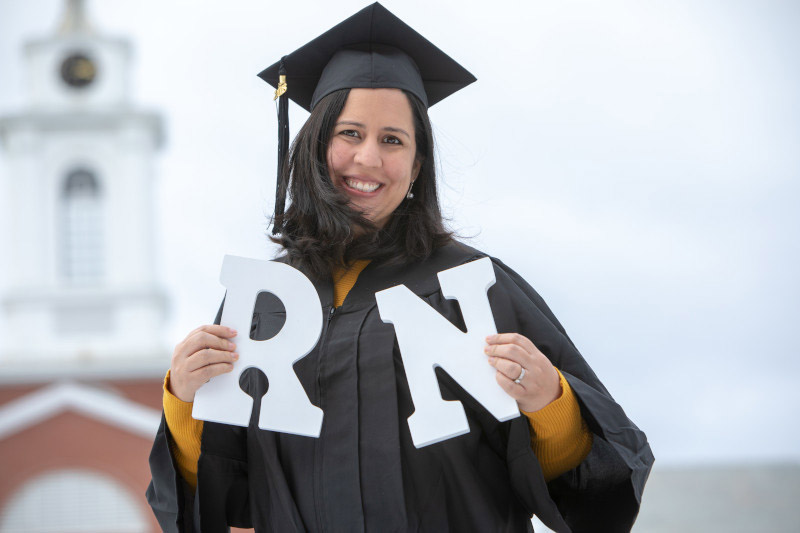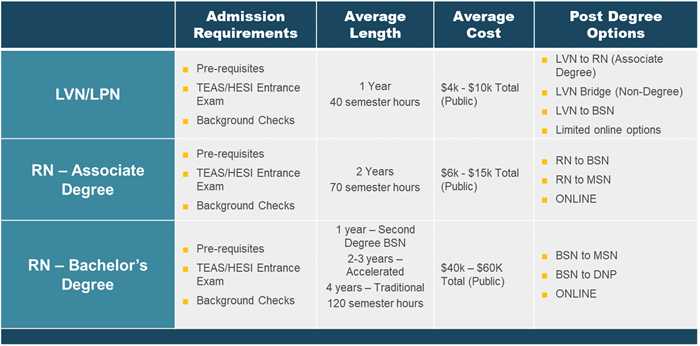The future of the nursing career field is very bright! It is among the top 10 largest occupations in the US and there are currently over 4 million nurses. That is four times the number of physicians, making it the largest segment of the healthcare workforce.
According to the Bureau of Labor Statistics, the nursing profession is expecting a higher than average growth rate of 7% through 2029. The US is experiencing a shortage of nurses that was expected to be around 500,000 by last year. This is largely due to the higher number of nurses retiring each year, a shortage of nursing faculty, and the aging population.
In my role with Bright Horizons, I talk with employees interested in becoming nurses who are not sure where to begin. There is a lot of information to consider and more than one way to get there. I always recommend checking with their state’s Board of Nursing as a starting point since it is something that leads to licensure and approvals or requirements vary greatly by state. They often even have a list of nursing programs you must select from.
Pathways to Obtain Licensure
In the field of nursing there are several different levels of certification or licensure which makes it a great career path for those who want or need to go slowly step by step. You can start out as a CNA (Certified Nursing Assistant) with a relatively short certificate or training program that only requires a HS Diploma or GED and is typically a few weeks or months long.
You could also start out as an LPN or LVN (Licensed Practical or Vocational Nurse). This program is typically a one-year certificate program or sometimes an associate degree. This level of nurse can be called LPN or LVN, depending on where in the country you reside, but it is still the same role.
The Registered Nurse is the most common license and you can either start here or go from LPN/LVN to RN. This license requires a full education program at one of these four levels:
- Diploma
- Associate Degree
- Bachelor’s Degree
- Master’s Degree
Associate Degree in Nursing
The most common way to obtain an RN license is through an Associate Degree in Nursing. The Associate Degree in Nursing (ADN or ASN) typically takes 2 years to complete (after pre-requisite coursework) and is generally less expensive than pursuing a full pre-licensure bachelor’s degree. It is primarily offered by community colleges and technical schools. Earning an Associate Degree in Nursing makes you eligible to take the NCLEX-RN, a pre-requisite for RN licensure in all U.S. states.
Another entry level RN option is the diploma or certificate program, but they have slowly begun to fade away as employers increasingly prefer job candidates with full degrees. Diploma programs focus on nursing concepts and clinical practice and are often hospital-based programs not through a college.
Bachelor’s Degree in Nursing
You can also skip the Associate Degree and go straight into a pre-licensure Bachelor’s in Nursing program. There are several options for these pre-licensure BSN programs and they mostly have to do with how much college coursework you have already completed. Direct entry programs are traditional BSN’s designed for those with little to no college credit. They are typically 4 -5 years in length, and students will complete liberal arts courses simultaneously while completing nursing support and nursing courses.
The transfer option is designed for those who already have pre-requisites and liberal arts coursework completed – or an associate degree in another field and just need the pre-requisites and nursing courses for their BSN.
The final option is called an Accelerated Second Degree Bachelor’s in Nursing (ABSN) program. These are designed for career changers who have a previous bachelor’s degree in another field. Since they are accelerated they are meant to be done in one year, so most of these programs require that you not work or work very little in order to be successful.
Master’s Degree in Nursing
The final, and newest, way to obtain RN licensure is to go straight into a pre-licensure Master’s degree in Nursing. You may see these called Entry-Level MSN programs. Because this is a newer option, there are not many programs yet so you would need to ensure there is one in your area. They are accelerated programs and very similar to the second degree BSN. They are a bit longer (15-24 months) and you end up with a Master’s degree instead of a BSN. These programs often offer a concentration outside of RN Generalist, which can be a great option for those who already know what specialty they want to go into.
Choosing the Best Path for You
Now that you know more about how to become a nurse and the various pathways and bridge program options out there, you may be wondering how to determine the best route for you.
Here are some things you should consider – these tend to be the biggest differentiators and reasons for someone choosing one path over another.
The first and most important is accreditation. In order to sit for the NCLEX and obtain your license, you must choose a school that has nursing-specific accreditation of which there are two (CCNE and ACEN). CCNE tends to accredit higher-level degrees and typically you will see ACEN accreditation for associate degrees, although they do accredit some bachelor programs.
The schedule and time commitment for nursing programs is demanding, however, there are some differences. It is important to think about what you can manage. Many pre-licensure nursing programs are full-time, on-campus programs and it is very hard to work full time while in one of these programs. There are schools that offer part-time or evening/weekend options, but not enough. Unfortunately, many of these programs are offered at private or career/vocational schools that are more expensive. Another option may be to start with an LPN/LVN program. This is a shorter time commitment for full time study or again you can look for a part-time program.
This leads to the next area to consider – cost. Be sure to look at the total cost of the different options and pathways you have available to you in your area. Apply for financial aid and search for scholarships. If you are eligible for tuition assistance through your organization, know what is covered under the policy. Do they cover all degree levels? What level of accreditation does your employer require?
State and licensing information is very important as well, become familiar with your state’s requirements to sit for the NCLEX, which is the end goal no matter what path you choose. Be sure to review your state’s Board of Nursing website. This is especially true when looking at online bridge program options that lead to licensure, such as LVN to RN /BSN or MSN programs.
Nursing is a huge, growing and changing field with so many options for career pathways, work locations, specialties and interests. Although there are many different ways to obtain RN licensure and get to that end goal of becoming a nurse, it is clear that furthering your education has its benefits and will offer even more opportunities and room for growth – both financial and personal. For more information, I just presented a webinar on Getting your RN: Bridging the Gap Between the Classroom and Clinical Practice. I’m confident that if you are truly motivated, you can find a program or a pathway to get there that will work for you.





